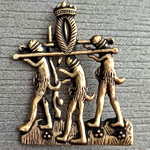Medieval pilgrim's badges and erotic tokens from the late Middle Ages
Here you can buy reproductions of medieval pilgrim badges made of bronze or in silver-plated.
 In the medieval shop of PERA PERIS - House of History, you can buy authentic replicas of so-called secular signs and medieval pilgrim badges from the Middle Ages. These have been made true to detail according to historical models from the late Middle Ages. In addition to the typical medieval pilgrimage signs depicting religious themes, you can also find a large selection of signs with bawdily erotic depictions, which were very common in the late Middle Ages. In contrast to the pilgrimage signs often made of pewter in the Middle Ages, we offer you these gems of medieval craftsmanship exclusively made of high-quality cast bronze and in real silver-plated.
In the medieval shop of PERA PERIS - House of History, you can buy authentic replicas of so-called secular signs and medieval pilgrim badges from the Middle Ages. These have been made true to detail according to historical models from the late Middle Ages. In addition to the typical medieval pilgrimage signs depicting religious themes, you can also find a large selection of signs with bawdily erotic depictions, which were very common in the late Middle Ages. In contrast to the pilgrimage signs often made of pewter in the Middle Ages, we offer you these gems of medieval craftsmanship exclusively made of high-quality cast bronze and in real silver-plated.Retailers for LARP or medieval re-enactment are welcome to register for our medieval wholesale store.
Products
show 1 to 22 (out of a total of 22 articles)
Dealers for museum supplies, medieval and Viking re-enactment or LARP are cordially invited to register as retailer for wholesale in Pera Peri's medieval shop. We guarantee the best quality at good prices with short delivery times!

